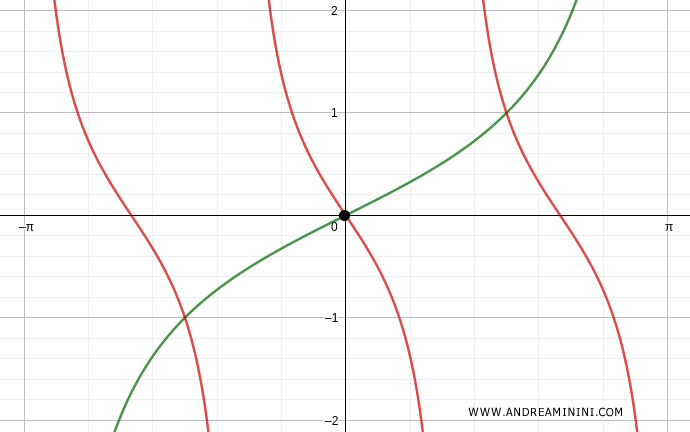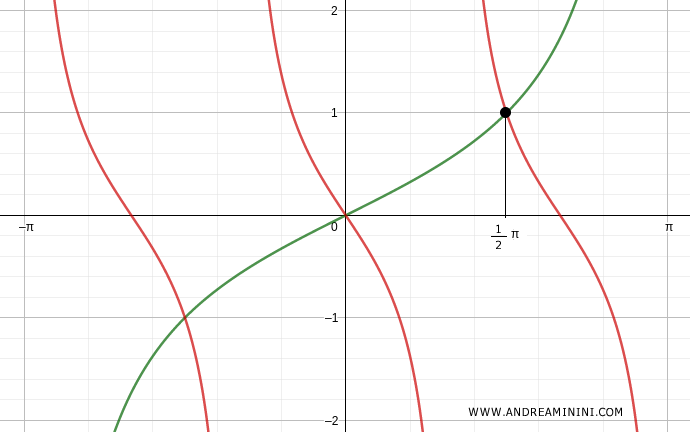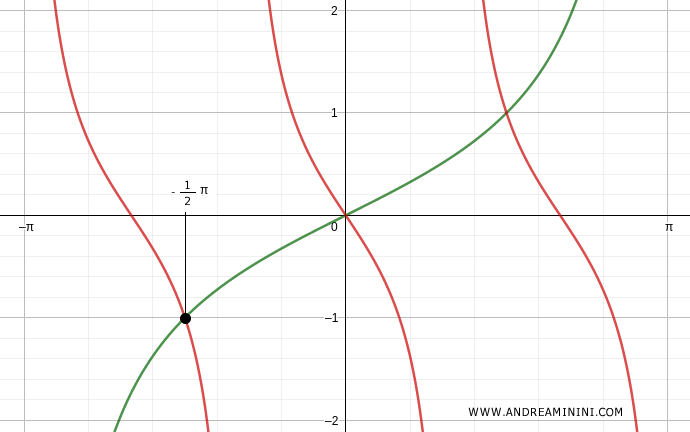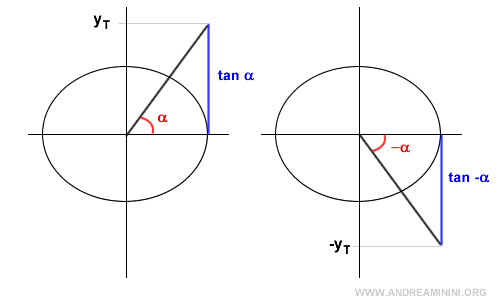Trigonometric Equation: tan(a) = -tan(b)
The trigonometric equation $$ \tan \alpha = - \tan \alpha' $$ can be solved using the formula $$ \tan \alpha = \tan (-\alpha') $$ which leads to the general solutions: $$ \alpha = (-\alpha') + k \pi $$ where k is any integer within the range (-∞, ∞).
The tangent is a periodic function with a period of π radians.
Therefore, the equation tan(α) = -tan(α') has infinitely many solutions, determined by integer multiples of the straight angle π.
A Practical Example
Let’s solve the trigonometric equation:
$$ \tan \frac{1}{2} x = - \tan \frac{3}{2} x $$
Since the tangent is an odd function, we can rewrite -tan(3/2x) as tan(-3/2x):
$$ \tan \frac{1}{2} x = \tan -\frac{3}{2} x $$
This transforms the equation into the standard form tan(α) = tan(α'):
$$ \alpha = \frac{1}{2} x $$ $$ \alpha' = -\frac{3}{2} x $$
Now, we can apply the general solution formula for a tan(α) = tan(α') equation:
$$ \alpha = \alpha' + k \pi $$
Substituting α and α' with the tangent arguments, we get:
$$ \frac{1}{2} x = (-\frac{3}{2} x) + k \pi $$
Rearranging to isolate the variable x:
$$ \frac{1}{2} x + \frac{3}{2} x = k \pi $$
$$ \frac{1+3}{2} x = k \pi $$
$$ \frac{4}{2} x = k \pi $$
$$ 2x = k \pi $$
$$ x = \frac{1}{2} k \pi $$
Thus, the equation has infinitely many solutions, where k is any integer.
To find specific solutions, we can assign different values to k.
Verification for k=0
$$ x = \frac{1}{2} k \pi $$
$$ x = \frac{1}{2} (0) \pi $$
$$ x = 0 $$
The first solution is the trivial case x = 0.

Verification for k=1
$$ x = \frac{1}{2} k \pi $$
$$ x = \frac{1}{2} (1) \pi $$
$$ x = \frac{1}{2} \pi $$
The second solution is x = 1/2π.

Verification for k=-1
$$ x = \frac{1}{2} k \pi $$
$$ x = \frac{1}{2} (-1) \pi $$
$$ x = -\frac{1}{2} \pi $$
The third solution is x = -1/2π.

By continuing with k = 2, -2, 3, ..., we can identify the remaining infinite solutions of the equation.
The Proof
The tangent is an odd function:
$$ -\tan \alpha = \tan (-\alpha) $$
Graphically:

Thus, a trigonometric equation involving the tangent -tan(α'):
$$ \tan \alpha = -\tan \alpha' $$
can be rewritten equivalently as:
$$ \tan \alpha = \tan (-\alpha') $$
This allows us to solve the equation as a tan(α) = tan(α') problem:
$$ \alpha = \alpha' + k \pi $$
where k is any integer, and π radians (180°) corresponds to the periodicity of the tangent function.
In this case, the argument of the tangent is the opposite angle -α':
$$ \alpha = (-\alpha') + k \pi $$
This establishes the formula for solving the trigonometric equation.
And so forth.
